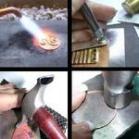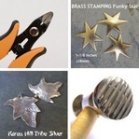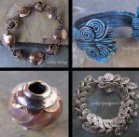An "in-gauging" question
by Lori A Croy
(Elkhart, IN)
First off I want to thank you for your site! So much info available for free. Unfortunately, in my journey to learn metal work I have not always found it to be so. Anyhoo, I have been a stained glass artist for over 10 years and it seems that getting into metal working is a natural evolution for me. I see the potential for use both in stained glass and as a new exciting art in its own right. I have experience with soldering, basic patinas, hinge making etc... My current obsession is making a memory box pendant from a piece of copper sheeting to a finished and filled pendant. The problem I am running into is figuring out the proper gauge to use. I do not plan to embellish the box itself, just patina it. So the metal would not be exposed to a great deal of work hardening in the process of making it. I might do some etching on the outside of the box or add accents with some non adhesive copper foil I already have. (Again lots of ideas) I am just not sure what gauge the copper should be and as it can get quite pricey I don't want to buy a roll or plate only to find it isn't right. Any suggestions or help would be much appreciated. I have made a couple of paper models of the box itself and am getting close to having a pattern I am happy with so it's time to solve the gauge dilemma.
Again, thank you for the site and your willingness to help us "newbies" out. Be blessed. Lori
Stacy's Answer:
Hi Lori!
You'll want to use a gauge that will hold it's shape and not warp on you while you're fabricating it. As you may want to etch the surface too, I would suggest using 22 gauge for your box. This gauge should provide the thickness you need without being too heavy for a small pendant. Thinner gauges such as 26 gauge can be used for tube shaped containers.
Copper sheeting is relatively inexpensive and you can buy it at jewelry supply companies such as Rio Grande or often at local hardware stores such as Ace. Ace also sells smaller pieces of sheeting for under $10. (perfect for experimenting!) But as you say, it all adds up and can get pricey!
Just a tip when soldering copper.........copper is a "dirty metal" as it oxidizes very quickly. Because of that, you must bring the copper up to temperature quickly for your solder to flow before too much of a layer of crud forms while applying the torch. You'll get a stronger join that way. If you're making a box, you'll need to back-solder and I've only seen copper solder in Hard. To cover your silver solder joins, you can copper plate the box once you've finished soldering it by adding a piece of steel such as a large washer to your hot pickle solution. This will cause a layer of copper oxides to form on the surface of what ever you put in the pickle, covering the silver solder. Once you remove the steel, the pickle is no longer a plating solution.
Sounds like a fun project! Have fun creating!
















